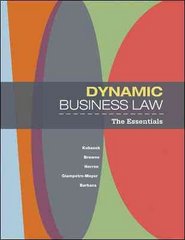Question
Question [3]: Just as for consumers, we can use the same trick for aggregation on the firm side. Each firm has discontinuous demand/supply, but in
Question [3]: Just as for consumers, we can use the same trick for aggregation on the firm side. Each firm has discontinuous demand/supply, but in aggregate we will get (hopefully) a nice function.
Suppose there is a unit mass of firms (this language means that there are infinitely many firms who are all miniscule and together add to 1; firms are treated like a realization of a continuous random variable, in effect.) 1 Each firm can only hire zero or one unit of labour l, which has price w. Each firm has a technology indexed by which determines the level of the output good. The technology for a given firm is given by the production function f(l) = l. Suppose that the technology parameter for the firms is distributed on the interval [0, 4] according to
f() = ( 1 /2 - 1/ 4 if 2
( 1/ 2 + 1 /4 if 2
(It may be worthwhile to note that this means that there are no firms at the average productivity! Firms tend to be high or low productivity, but there are none in the middle.) Output y has price p. Firms are profit maximizers.
Here the level of output varies for those firms that produce.
What is aggregate demand for labour?
What is aggregate supply of output?
Step by Step Solution
There are 3 Steps involved in it
Step: 1

Get Instant Access to Expert-Tailored Solutions
See step-by-step solutions with expert insights and AI powered tools for academic success
Step: 2

Step: 3

Ace Your Homework with AI
Get the answers you need in no time with our AI-driven, step-by-step assistance
Get Started


